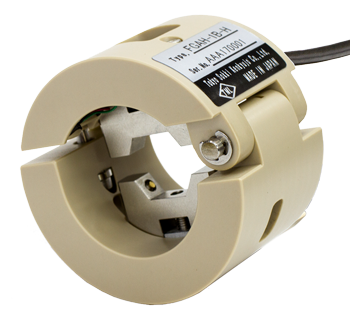Frictional type Axial Strain Transducer
Frictional type Axial Strain Transducer FGAH-1B-R / FGAH-1B-H
Approximately 1000 × 10-6 strain
This is a transducer to measure axial strain of tie-rod of a car. It is also suited to measure axial strain of tension rod used in aseismic reinforcement structure or in steel frame structure. Since frictional strain gauges are used in this transducer, installation is completed and it gets ready for measurement by merely pinching the rod with the transducer, without detaching the rod. There is no need of technical skill or complicated works for attaching strain gauges on the rod. It is applicable either to round rod or hexagonal rod by replacing the spacer and fixing bracket.

- Features
- No need to remove an in-place rod; simply clamps on
- Facilitates tension control of rods between sheet piles and architectural structures at civil engineering projects, can be removed and used again
- Applicable rod diameters are ø10 to 25 mm, width across flats 13 to 25 mm
- Compact, lightweight design allowing installation even in narrow spaces
-
Specifications
Type FGAH-1B-R FGAH-1B-H Applicable shaft Round shape
Φ 10.0 to 25.0 mmHexagon shape
Width across flats
13.0 to 25.0 mmCapacity Approx. 1000 x 10-6 strain Rated output Approx. 2600 x 10-6 strain Non-linearity 1%RO Allowable temperature range -30 to +60 ℃(no dew condensation) Frequency response Approx. 6.5 kHz Input/output resistance 1000 Ω ± 3% Sensor mode Full bridge Dimensions Approx. Φ 52 x 35 mm Weight Approx. 55 g(excluding spacers and cable) Protection rating Equivalent to IP51 Recommended exciting voltage 2 V Allowable exciting voltage 5 V Input/output cable Φ 3.2 mm 0.08 mm² 4-core shielded vinyl cable 5 m [Test conditions] Test piece
1. Diameter 10 mm 2. Inner diameter 6.2 mm 3. Material SNCM439 4. Elastic modulus 208,000 N/mm2 (our in-house test result) 5. Poisson’s ratio 0.29 (our in-house test result) 6. Surface roughness Ra0.8 7. Hardness HRC38 * : This transducer may not be applicable depending on the material, surface roughness and/or surface treatment of the rod.
More Information


